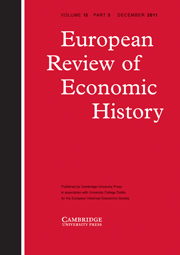Crossref Citations
This article has been cited by the following publications. This list is generated based on data provided by
Crossref.
Hale, Matthew
Hawkins, Richard
and
Wright, Catherine
2007.
List of publications on the economic and social history of Great Britain and Ireland published in 2006.
The Economic History Review,
Vol. 60,
Issue. 4,
p.
773.
PRATT, DAVID
SCHOFIELD, P. R.
FRENCH, HENRY
KIRBY, PETER
FREEMAN, MARK
GREAVES, JULIAN
and
PEMBERTON, HUGH
2008.
Review of periodical literature published in 2006.
The Economic History Review,
Vol. 61,
Issue. 1,
p.
183.
Neal, Larry
2009.
The Origins and Development of Financial Markets and Institutions.
p.
450.
Neal, Larry
2009.
The Origins and Development of Financial Markets and Institutions.
p.
241.
Alquist, Ron
2010.
How important is liquidity risk for sovereign bond risk premia? Evidence from the London stock exchange.
Journal of International Economics,
Vol. 82,
Issue. 2,
p.
219.
Chambers, David
2010.
Going public in interwar Britain.
Financial History Review,
Vol. 17,
Issue. 1,
p.
51.
Stringham, Edward Peter
and
Chen, Ivan
2012.
The Alternative of Private Regulation: The London Stock Exchange's Alternative Investment Market as a Model.
Economic Affairs,
Vol. 32,
Issue. 3,
p.
37.
Flores, Juan H.
2012.
Crying on Lombard Street: fixing sovereign defaults in the 1890s.
European Review of History: Revue europeenne d'histoire,
Vol. 19,
Issue. 6,
p.
979.
Hautcoeur, Pierre‐Cyrille
and
Riva, Angelo
2012.
The Paris financial market in the nineteenth century: complementarities and competition in microstructures1.
The Economic History Review,
Vol. 65,
Issue. 4,
p.
1326.
Flandreau, M.
Flores, J.H.
Gaillard, N.
and
Nieto-Parra, S.
2013.
Handbook of Key Global Financial Markets, Institutions, and Infrastructure.
p.
281.
Esteves, Rui
and
Tuncer, Ali Coskun
2014.
Feeling the Blues. Moral Hazard and Debt Dilution in Eurobonds Before 1914.
SSRN Electronic Journal,
Burhop, Carsten
Chambers, David
and
Cheffins, Brian
2014.
Regulating IPOs: Evidence from going public in London, 1900–1913.
Explorations in Economic History,
Vol. 51,
Issue. ,
p.
60.
Odlyzko, Andrew
2014.
Economically Irrational Pricing of 19th Century British Government Bonds.
SSRN Electronic Journal,
Olstein, Diego
2015.
Thinking History Globally.
p.
125.
O'Sullivan, Mary A.
2015.
Yankee Doodle went toLondon:Anglo‐American breweries and theLondon securities market, 1888–92.
The Economic History Review,
Vol. 68,
Issue. 4,
p.
1365.
Odlyzko, Andrew
2016.
Financialization of the Early Victorian Economy and the London Stock Exchange.
SSRN Electronic Journal ,
Zendejas, Juan H. Flores
2016.
Contractual Knowledge.
p.
61.
Weidemaier, Mark C.
and
Gulati, G. Mitu
2016.
Differing Perceptions? Market Practice and the Evolution of Foreign Sovereign Immunity.
SSRN Electronic Journal,
Flores Zendejas, Juan H.
2016.
3. Les origines et défis des marchés de dette publique : bénédiction ou malédiction ?.
Regards croisés sur l'économie,
Vol. n° 17,
Issue. 2,
p.
52.
Odlyzko, Andrew
2016.
Economically irrational pricing of nineteenth-century British government bonds.
Financial History Review,
Vol. 23,
Issue. 3,
p.
277.


